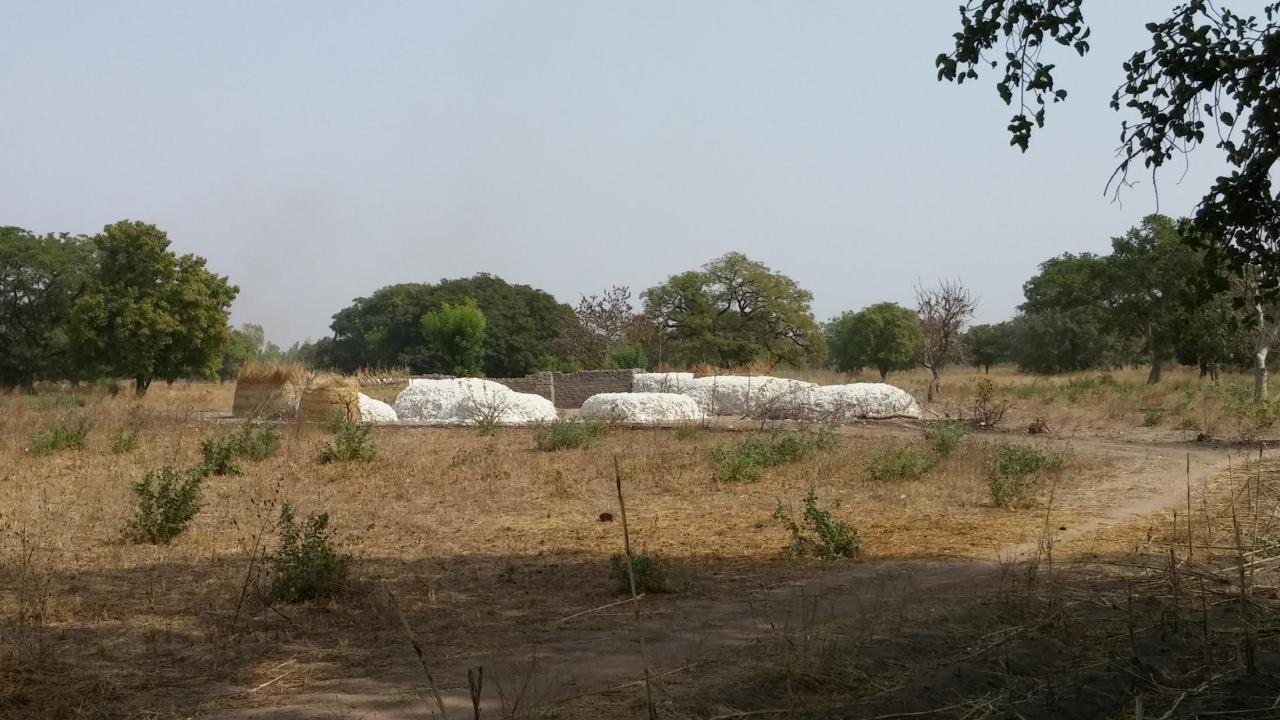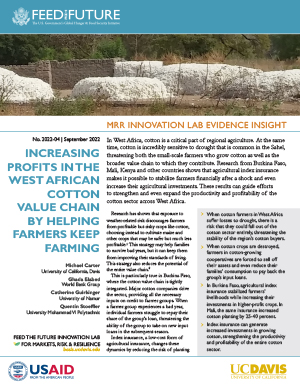
In West Africa, cotton is a critical part of regional agriculture. At the same time, cotton is incredibly sensitive to drought that is common in the Sahel, threatening both the small-scale farmers who grow cotton as well as the broader value chain to which they contribute.
Research from Burkina Faso, Mali, Kenya and other countries shows that agricultural index insurance makes it possible to stabilize farmers financially after a shock and even increase their agricultural investments. These results can guide efforts to strengthen and even expand the productivity and profitability of the cotton sector across West Africa.
Highlights
- When cotton farmers in West Africa suffer losses to drought, there is a risk that they could fall out of the cotton sector entirely, threatening the stability of the region’s cotton buyers.
- When cotton crops are destroyed, farmers in cotton-growing cooperatives are forced to sell off their assets and even reduce their families’ consumption to pay back the group’s input loans.
- In Burkina Faso, agricultural index insurance stabilized farmers’ livelihoods while increasing their investments in higher-profit crops. In Mali, the same insurance increased cotton planting by 25-40 percent.
- Index insurance can generate increased investments in growing cotton, strengthening the productivity and profitability of the entire cotton sector.
Research has shown that exposure to weather-related risk discourages farmers from profitable but risky crops like cotton, choosing instead to cultivate maize and other crops that may be safer but much less profitable.1 This strategy may help families to survive bad years, but it can keep them from improving their standards of living. This strategy also reduces the potential of the entire value chain.[2]
This is particularly true in Burkina Faso, where the cotton value chain is tightly integrated. Major cotton companies drive the sector, providing all the necessary inputs on credit to farmer groups. When a farmer group experiences a bad year, individual farmers struggle to repay their share of the group’s loan, threatening the ability of the group to take on new input loans in the subsequent season.
Index insurance, a low-cost form of agricultural insurance, changes these dynamics by reducing the risk of planting a cash crop like cotton. Index insurance bases payouts on factors that predict losses across a geographic area, such as satellite measurements of vegetation or estimates of average yields. High-quality index insurance provides security that farmers can keep farming after a bad year.
From 2013-2015, we partnered with SOFITEX in Burkina Faso to measure the impacts of index insurance for small-scale cotton farmers. In spite of implementation challenges, our results show that insurance does have the potential to stabilize farmers’ livelihoods so they can keep growing cotton. As the risk of drought continues to increase, the alternative could be the gradual collapse of the sector as farmers who lose their crops fall out of the value chain entirely.
Insurance for Cotton in West Africa

Our research in Burkina Faso included 1,015 households from 80 farmer groups. The insurance was based on an area-yield index that released payments when average yields fell a specified level below the historical average. The insurance took advantage of SOFITEX being the only cotton buyer in the region and that it measures cotton production and area planted in order to loan inputs and issue payments for purchases.
In other field trials, index insurance has proven to stabilize farmers financially after a shock and also to unlock increased investments in productivity. A study from Kenya[3] found that insurance significantly increased investments in livestock while another[4] found that it protected both consumption and livestock holding after a drought. Research in Ghana[5] showed that insured farmers increased their investment in maize by 13-17 percent, and improved their ability to absorb shocks. These interventions increased investments in productivity because farmers believed they would receive payments when the funds were most needed.
Implementation challenges in our Burkina Faso study prevented the anticipated impacts on cotton planting in the year farmers were insured. However, the insurance did have significant impacts on other productive investments. We also gained valuable insights on how farmers cope with a shock with and without insurance payments. All of these results have implications for the broader cotton sector that depends on small-scale farmers.
Positive Impacts in Spite of Challenges
The insurance had no impact on cotton investments in the year farmers were insured mainly because insurance sales took place after farmers had begun sowing their fields. Even so, we found significant changes in agricultural investments in the following season. Previously insured farmers increased the area they planted with cotton by about 10 percent with roughly the same increase in yields. Previously insured farmers also increased their likelihood of renting land for cultivation by 15 percentage points.
When some farmers experienced losses after their fields were attacked by pests during a mid-season drought, the insurance released payments, but those payments arrived two months after farmer groups were required to pay back their loans. In 2014, 9 percent of farmers in our study failed to produce even 440 kilograms per hectare, the amount required to fully pay back their input loans.
Repaying input loans caused serious economic and social stress. Some farmers sold livestock while others worked as day laborers. Some were forced to sell almost everything they owned, even their stores of food. The situation also generated social conflicts in the affected villages.
Fortunately, when insurance payouts arrived farmers were able to undo most of the damage. They bought back the livestock and assets that they had sold, though at higher prices. Insurance payouts went to buying additional livestock, food, agricultural inputs and durables. Payouts also went toward paying school fees, cultivating new crops, increasing their cotton-planting area, paying back other loans and even paying for weddings.
Securing the Cotton Value Chain
Large-scale commodity buyers have a powerful incentive to keep farmers in their value chain by integrating a risk-management technology like index insurance. If an individual farmer loses a crop, the broader group of farmers is forced to make up the difference. If the majority of farmers in the group lose their crops, that group of farmers is likely to fall out of the value chain, reducing the future amount of cotton available to buy.
Insurance has shown tremendous promise in neighboring Mali, where we tested an identical intervention[6] and found that the insurance increased cotton cultivation by 25-40 percent in the insured year. The difference was that insurance sales took place early enough that farmers could change their input orders.
An investment in subsidizing the cost of the insurance, and even bundling it with input loans, can overcome most of the challenges we found during our study. The insurance would financially stabilize farmers after a drought shock, keeping them from costly measures to pay back input loans. Marketing input loans as having “loan protection” could also unlock the opportunity for farmers to choose to plant more, securing and even expanding the potential of the West African cotton sector.
[1] Dercon, S. 1996. “Risk, Crop Choice, and Savings: Evidence from Tanzania.” Economic Development and Cultural Change.
[2] Boucher, S. R.,M. R. Carter, and C. Guirkinger. 2008. “Risk Rationing and Wealth Effects in Credit Markets: Theory and Implications for Agricultural Development.” American Journal of Agricultural Economics.
[3] Jensen, N.D., et al. 2016. “Index Insurance Quality and Basis Risk: Evidence from Northern Kenya.” American Journal of Agricultural Economics.
[4] Janzen, S. A., et al. 2018. “After the Drought: The Impact of Microinsurance on Consumption Smoothing and Asset Protection.” American Journal of Agricultural Economics.
[5] Karlan, D., et al. 2014. “Agricultural Decisions after Relaxing Credit and Risk Constraints.” Quarterly Journal of Economics.
[6] Stoeffler, Q., et al. 2022. “The Spillover Impact of Index Insurance on Agricultural Investment by Cotton Farmers in Burkina Faso.” World Bank Economic Review.
This report is made possible by the generous support of the American people through the United States Agency for International Development (USAID) cooperative agreement 7200AA19LE00004. The contents are the responsibility of the Feed the Future Innovation Lab for Markets, Risk and Resilience and do not necessarily reflect the views of USAID or the United States Government.
